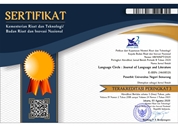APPLICATIVE CONSTRUCTIONS IN JAVANESE
(1) Semarang State University
Abstract
Keywords
Full Text:
PDFReferences
Badib, A. A. 1980. Some major constructions in Javanese: a lexicase approach. PhD dissertation, Monash University, Melbourne.
Blake, B. J. 1990. Relational grammar. London: Routledge.
Bresnan, J., and J. M. Kanerva. 1989. Locative inversion in Chichewa: a case study of factorization in grammar. Linguistic Inquiry 20:1: 1-50.
Davies, W. D. 1990b. Javanese evidence for subject-to-object raising. In K. Dziwirek, P. Farrell, and E. Mejias-Bikandi (eds.),Grammatical relations: a cross-theoretical perspective, 95-108. Stanford: CSLI-Stanford University.
Davies, W. D. 1995. Javanese adversatives, passives and Mapping Theory. Journal of Linguistics 31: 15-31.
Dixon, R. M. W., and A. Y. Aikhenvald. 2000. Changing valency: case studies in transitivity. Cambridge: Cambridge University Press
Dryer, M. 1986. Primary objects, secondary objects, and antidative. Language 62: 808- 845.
Ewing, M. 1999. The clause in Cirebon Javanese conversation. PhD dissertation, University of California, Santa Barbara.
Hudson, R. 1992. So-called ‘double objects’ and grammatical relations. Language 68: 1: 251- 276.
Palmer, F. R. 1994. Grammatical roles and relations. Cambridge: Cambridge University Press
Poedjosoedarmo, S. et al. 1979. Morfologi bahasa Jawa. Jakarta: Pusat Pembinaan dan Pengembangan Bahasa, Departemen Pendidikan dan Kebudayaan.
Shibatani, M. 1996. Applicatives and benefactives: a cognitive account. In M. Shibatani and S. A. Thompson (eds.), Grammatical constructions. Oxford: Clarendon Press.
Uhlenbeck, E. M. 1978. Studies in Javanese morphology. The Hague: Martinus Nihoff.
Verhaar, J. W. M. 1983. The syntax of ‘yang’ in Indonesian. In A. Halim, L. Carrington, and S. A. Wurm (eds.), Papers from the third international conference on Austronesian
Linguistics, vol. 4: thematic variation. Pacific Linguistics C-77, 43-70.
Refbacks
- There are currently no refbacks.

This work is licensed under a Creative Commons Attribution 4.0 International License

